Abstract
Plantar fasciitis is the most common cause of heel pain. The diagnosis of plantar fasciitis is primarily based on the presentation of symptoms and physical examination. Patients usually complain of heel pain at the medial calcaneal tubercle when taking their first step in the morning or when walking after resting. Diagnostic imaging is rarely required for the initial diagnosis of plantar fasciitis; however, it can be used for differential diagnosis. Conservative treatments, such as stretching, rest, ice massage, oral analgesics, foot orthotics, use of night splint, and corticosteroid injection, may be effective. The majority of patients report improvement with conservative treatments, and those who show no response from conservative treatments for a duration of six months or longer can consider extracorporeal shock wave therapy or surgery.
Go to : 
REFERENCES
1.Dunn JE., Link CL., Felson DT., Crincoli MG., Keysor JJ., McKin- lay JB. Prevalence of foot and ankle conditions in a multiethnic community sample of older adults. Am J Epidemiol. 2224. 159:491–8.

2.Lemont H., Ammirati KM., Usen N. Plantar fasciitis: a degenerative process (fasciosis) without inflammation. J Am Podiatr Med Assoc. 2223. 93:234–7.
3.Thomas JL., Christensen JC., Kravitz SR., Mendicino RW., Schuberth JM., Vanore JV, et al. The diagnosis and treatment of heel pain: a clinical practice guideline-revision 2010. J Foot Ankle Surg. 2212. 49 3 Suppl:S1–19.

4.Hicks JH. The mechanics of the foot1 II1 The plantar aponeurosis and the arch. J Anat. 1954. 88:25–32.
5.Riddle DL., Pulisic M., Pidcoe P., Johnson RE. Risk factors for Plantar fasciitis: a matched case-control study. J Bone Joint Surg Am. 2223. 85:872–7.
6.May TJ., Judy TA., Conti M., Cowan JE. Current treatment of plantar fasciitis. Curr Sports Med Rep. 2222. 1:278–84.

7.Goff JD., Crawford R. Diagnosis and treatment of plantar fasciitis Am Fam Physician. 2211. 84:676–82.
8.Cardinal E., Chhem RK., Beauregard CG., Aubin B., Pelle-tier M. Plantar fasciitis: sonographic evaluation. Radiology. 1996. 221:257–9.

9.Sorrentino F., Iovane A., Vetro A., Vaccari A., Mantia R., Midiri M. Role of high-resolution ultrasound in guiding treatment of idiopathic plantar fasciitis with minimally invasive techniques. Radiol Med. 2228. 113:486–95.

10.Tsai WC., Chiu MF., Wang CL., Tang FT., Wong MK. Ultrasound evaluation of plantar fasciitis. Scand J Rheumatol. 2222. 29:255–9.
11.Steinbach LS. Topics in magnetic resonance imaging. Philadelphia: Lippincott Williams & Wilkins;1998. p1311-26.
12.Kim BS., Lee KB., Choi J., Park YB., Baik LB. Extracorporeal shock wave therapy (ESWT) in patients with chronic proximal plantar fasciitis. J Korean Foot Ankle Soc1. 2226. 12:163–7.
13.Yoon K., Kim SB., Park JS. Ultrasonographic findings in plantar fasciitis1 J Korean Acad Rehabil Med. 2222. 26:181–6.
14.Williams SK., Brage M. Heel pain-plantar fasciitis and Achilles enthesopathy. Clin Sports Med. 2224. 23:123–44.

15.Wolgin M., Cook C., Graham C., Mauldin D. Conservative treatment of plantar heel pain: long-term follow-up. Foot Ankle Int. 1994. 15:97–122.

16.Digiovanni BF., Nawoczenski DA., Malay DP., Graci PA., Williams TT., Wilding GE, et al. Plantar fascia-specific stretching exercise improves outcomes in patients with chronic plantar fasciitis. A prospective clinical trial with two-year follow-up. J Bone Joint Surg Am. 2226. 88:1775–81.
17.Donley BG., Moore T., Sferra J., Gozdanovic J., Smith R. The efficacy of oral nonsteroidal anti-inflammatory medication (NSAID) in the treatment of plantar fasciitis: a randomized, prospective, placebo-controlled study. Foot Ankle Int. 2227. 28:22–3.

18.Batt ME., Tanji JL., Skattum N. Plantar fasciitis: a prospective randomized clinical trial of the tension night splint. Clin J Sport Med. 1996. 6:158–62.
19.Landorf KB., Keenan AM., Herbert RD. Effectiveness of foot orthoses to treat plantar fasciitis: a randomized trial. Arch Intern Med. 2226. 166:1325–12.
20.Powell M., Post WR., Keener J., Wearden S. Effective treatment of chronic plantar fasciitis with dorsiflexion night splints: a crossover prospective randomized outcome study. Foot Ankle Int. 1998. 19:12–8.

21.Mizel MS., Marymont JV., Trepman E. Treatment of plantar fasciitis with a night splint and shoe modification consisting of a steel shank and anterior rocker bottom. Foot Ankle Int. 1996. 17:732–5.

22.Crawford F., Atkins D., Young P., Edwards J. Steroid injection for heel pain: evidence of short-term effectiveness. A randomized controlled trial. Rheumatology (Oxford). 1999. 38:974–7.

23.Kirkland P., Beeson P. Use of primary corticosteroid injection in the management of plantar fasciopathy: is it time to challenge existing practice? J Am Podiatr Med Assoc. 2013. 103:418–29.
24.Buchbinder R. Clinical practice1 Plantar fasciitis1 N Engl J Med. 2004. 350:2159–66.
25.Li Z., Yu A., Qi B., Zhao Y., Wang W., Li P, et al. Corticosteroid versus placebo injection for plantar fasciitis: a meta-analysis of randomized controlled trials. Exp Ther Med. 2015. 9:2263–8.

26.Acevedo JI., Beskin JL. Complications of plantar fascia rupture associated with corticosteroid injection. Foot Ankle Int. 1998. 19:91–7.

27.Babcock MS., Foster L., Pasquina P., Jabbari B. Treatment of pain attributed to plantar fasciitis with botulinum toxin A: a short-term, randomized, placebo-controlled, double-blind study. Am J Phys Med Rehabil. 2005. 84:649–54.
28.Peerbooms JC., van Laar W., Faber F., Schuller HM., van der Ho-even H., Gosens T. Use of platelet rich plasma to treat plantar fasciitis: design of a multi centre randomized controlled trial. BMC Musculoskelet Disord. 2010. 11:69.

29.Rompe JD., Furia J., Weil L., Maffulli N. Shock wave therapy for chronic plantar fasciopathy. Br Med Bull. 2007. 81-82:183–228.

30.Theodore GH., Buch M., Amendola A., Bachmann C., Fleming LL., Zingas C. Extracorporeal shock wave therapy for the treatment of plantar fasciitis. Foot Ankle Int. 2004. 25:290–7.

31.Fuselier HA., Prats L., Fontenot C., Gauthier A Jr. Comparison of mobile lithotripters at one institution: healthtronics lithotron, Dornier MFL-5000, and Dornier Doli. J Endourol. 1999. 13:539–42.
32.Leach RE., Seavey MS., Salter DK. Results of surgery in athletes with plantar fasciitis. Foot Ankle. 1986. 7:156–61.

33.Daly PJ., Kitaoka HB., Chao EY. Plantar fasciotomy for intractable plantar fasciitis: clinical results and biomechanical evaluation. Foot Ankle. 1992. 13:188–95.

34.Benton-Weil W., Borrelli AH., Weil LS Jr., Weil LS Sr. Percutaneous plantar fasciotomy: a minimally invasive procedure for recalcitrant plantar fasciitis. J Foot Ankle Surg. 1998. 37:269–72.

35.Tomczak RL., Haverstock BD. A retrospective comparison of endoscopic plantar fasciotomy to open plantar fasciotomy with heel spur resection for chronic plantar fasciitis/heel spur syndrome. J Foot Ankle Surg1. 1995. 34:305–11.

36.Wander DS. Endoscopic plantar fasciotomy versus traditional heel spur surgery. J Foot Ankle Surg. 1994. 33:322.
37.Marafkó C. Endoscopic partial plantar fasciotomy as a treatment alternative in plantar fasciitis. Acta Chir Orthop Traumatol Cech. 2007. 74:406–9.
38.Lundeen RO., Aziz S., Burks JB., Rose JM. Endoscopic plantar fasciotomy: a retrospective analysis of results in 53 patients. J Foot Ankle Surg. 2000. 39:208–17.

39.Herzenberg JE., Lamm BM., Corwin C., Sekel J. Isolated recession of the gastrocnemius muscle: the Baumann procedure. Foot Ankle Int. 2007. 28:1154–9.

40.Abbassian A., Kohls-Gatzoulis J., Solan MC. Proximal medial gastrocnemius release in the treatment of recalcitrant plantar fasciitis. Foot Ankle Int. 2012. 33:14–9.

41.Silfverskiöld N. Reduction of the uncrossed two-joint muscles of the leg to one joint muscles in spastic conditions. Acta Chir Scand. 1924. 56:315–30.
42.Maskill JD., Bohay DR., Anderson JG. Gastrocnemius recession to treat isolated foot pain. Foot Ankle Int. 2010. 31:19–23.

Go to : 
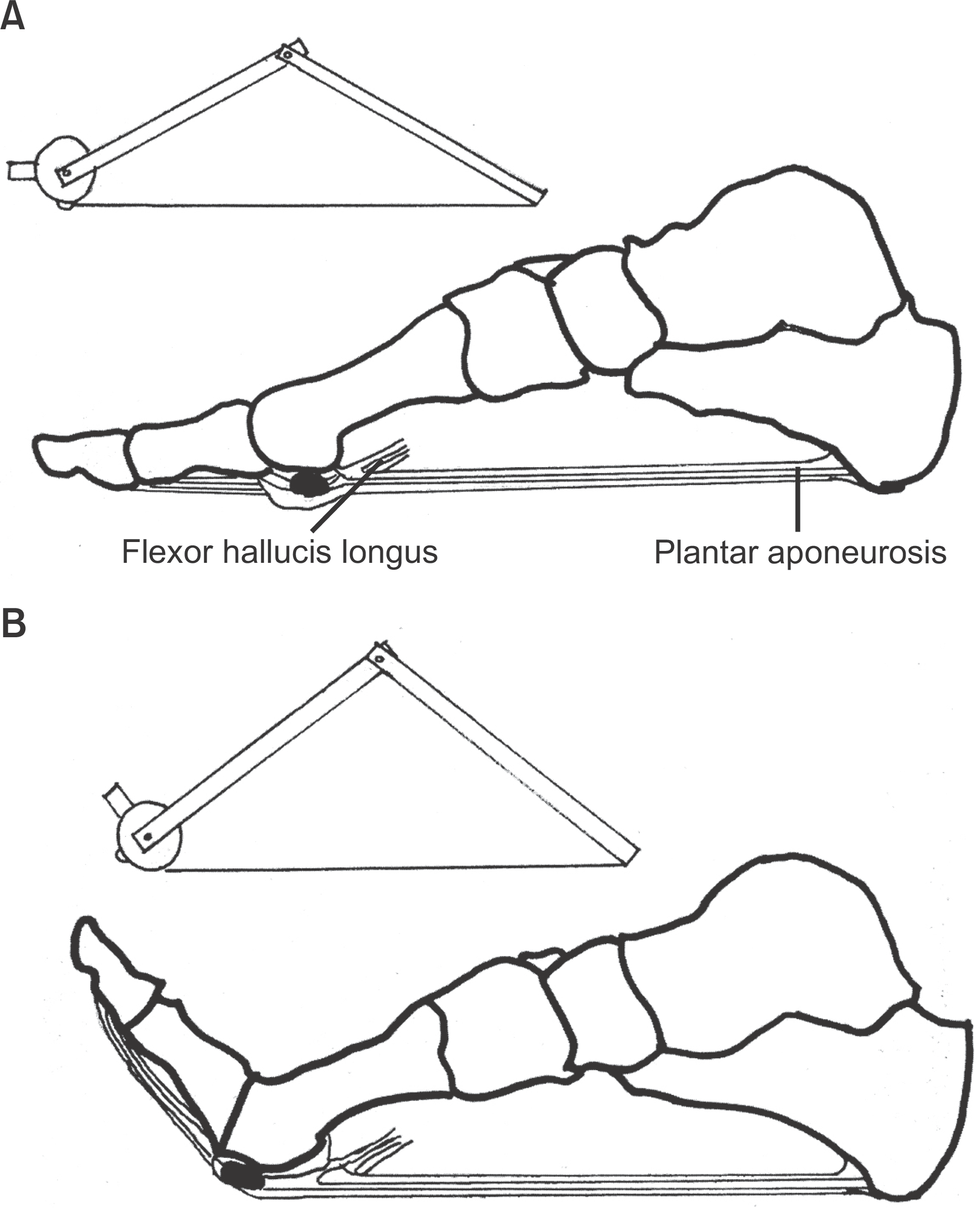 | Figure 1.Image shows the plantar fascia attaching proximally to the medial calcaneal tubercle and extending distally into the base of the periosteum of the proximal phalanx of each toe and the metatarsal heads (A) and undergoing tension during the latter weight-bearing stage and, as the metatarsophalangeal joints undergo dorsiflexion, applying a tractional force at its point of insertion on the calcaneus (B). Revised from the article of Hicks (J Anat. 1954;88:25-30).4)
|
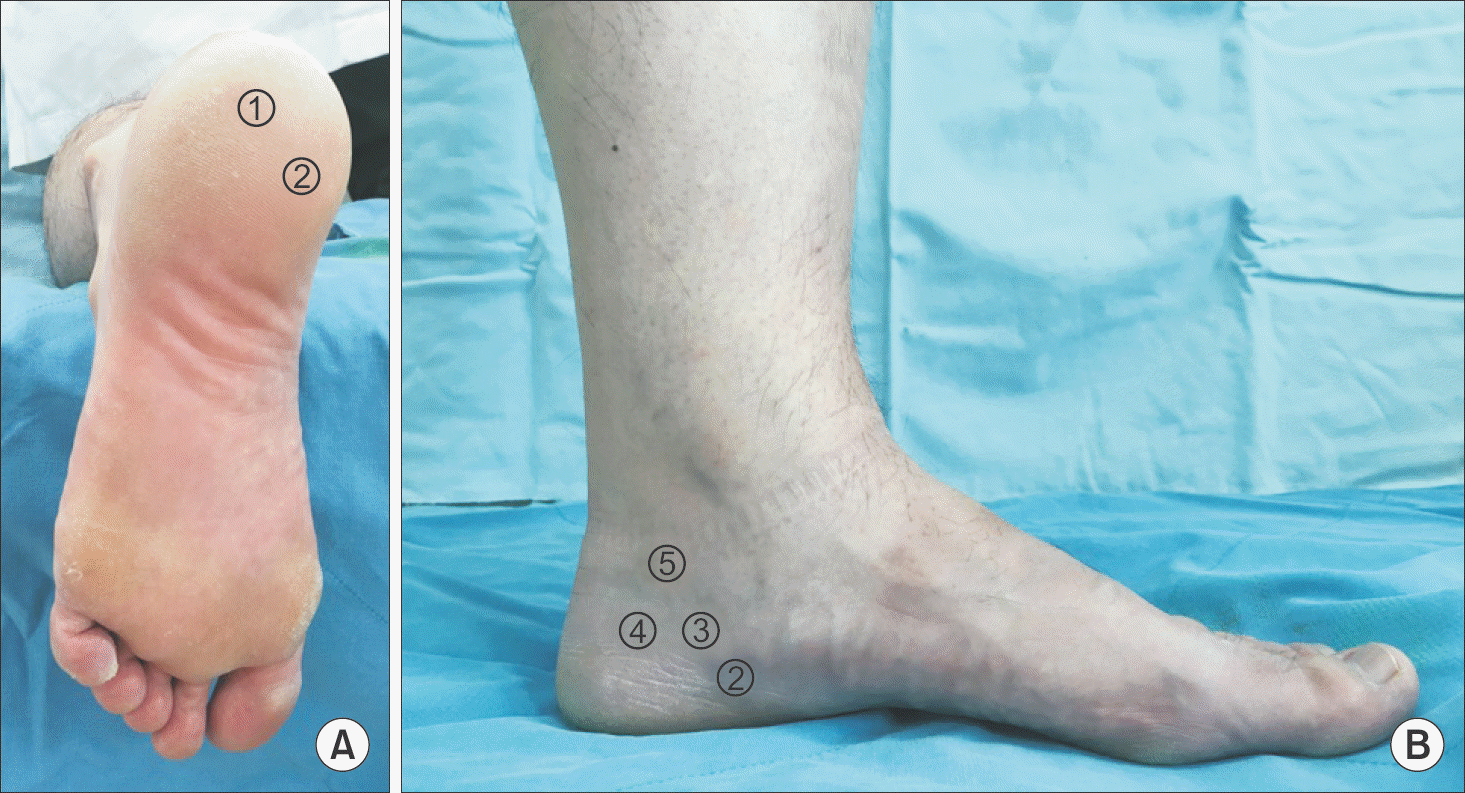 | Figure 2.Tenderness point of heel pain. (A) Sole of foot. (B) Medial aspect of foot. ① Heel pad atrophy. ② Plantar fasciitis. ③ Baxter nerve entrapment. ④ Calcaneal stress fracture. ⑤ Tarsal tunnel syndrome. |
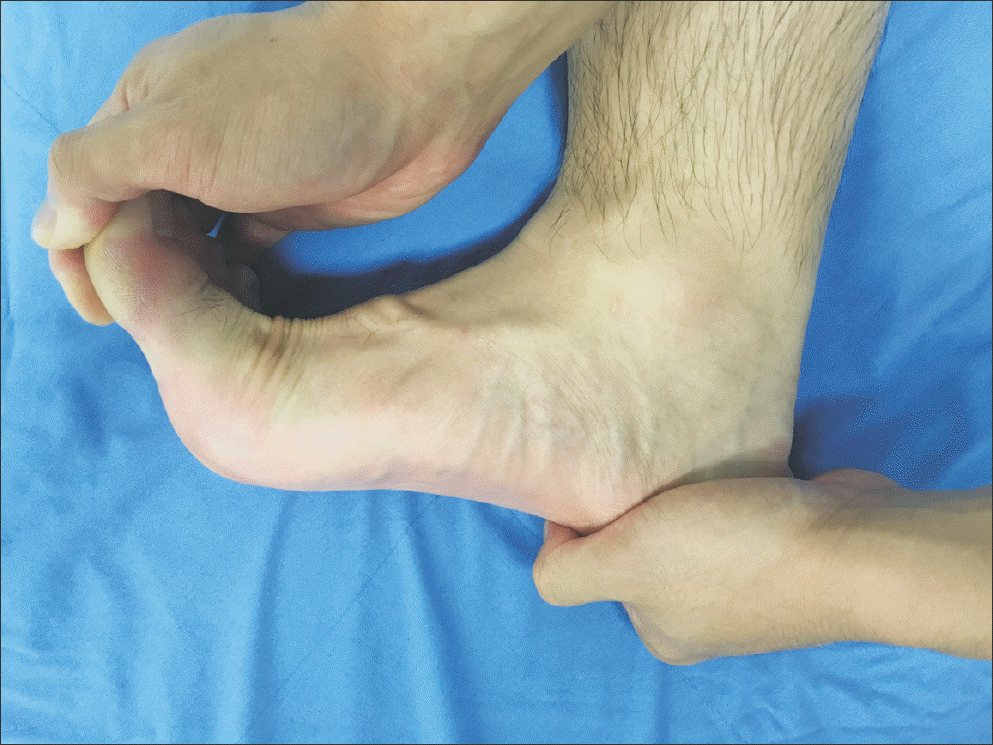 | Figure 4.Plantar fascia-specific stretch is performed by dorsiflexing the toes with one hand and palpating the plantar fascia with the other hand to ensure that it is taut. |
Table 1.
Risk Factors for Plantar Fasciitis
Table 2.
Differential Diagnosis for Heel Pain




 PDF
PDF ePub
ePub Citation
Citation Print
Print


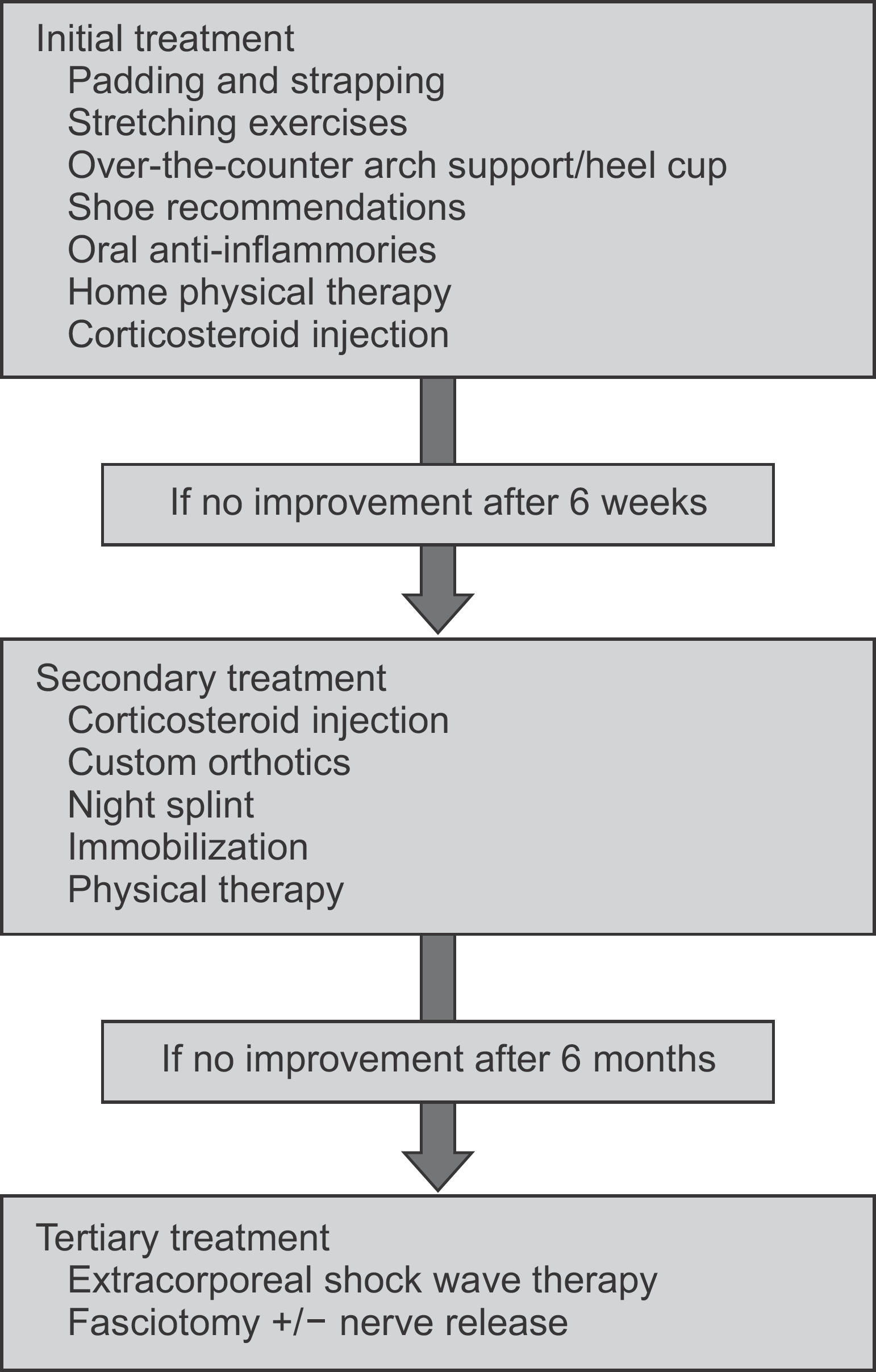
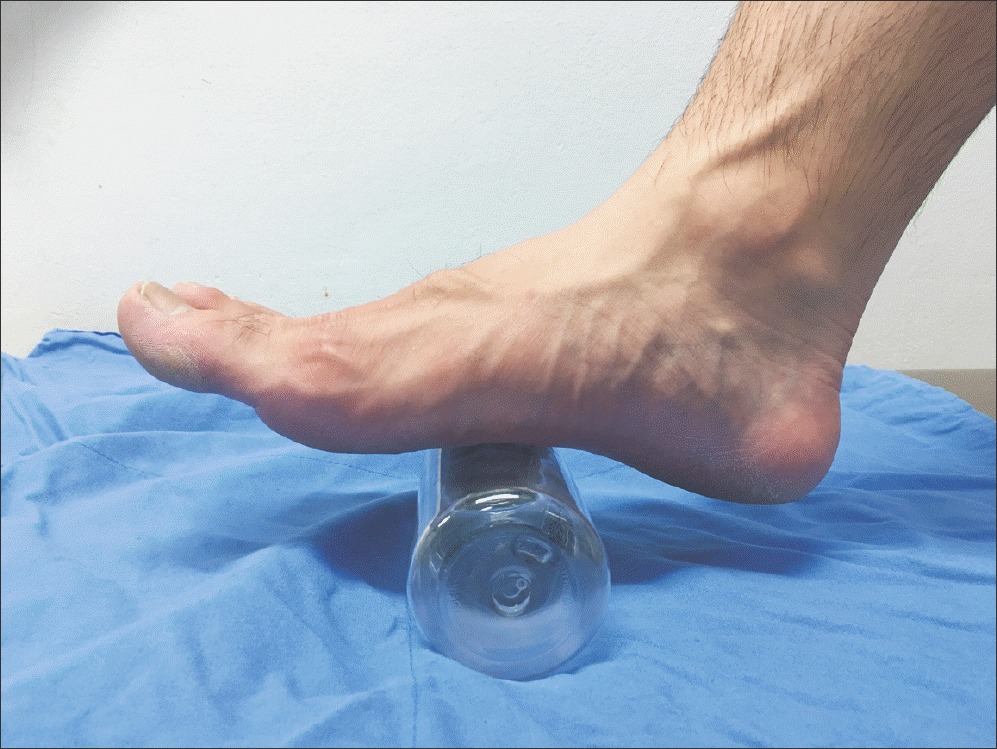
 XML Download
XML Download